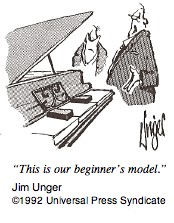Free Your Fingers!
You already know the patterns. Get a firmer grip on them. Unlock the potential and let freedom ring!
What the F?
Brought to you by the letter F, it’s a Z-Board: a six “stringed” instrument that lets musicians use both hands while applying all the familiar patterns of the string instrument fingerboard. (The ‘Z’ stands for “zebra” because from some angles the black and white keys seem to form stripes.)

Fast Facts and Films
Did you get it already? If not, watch this video. (Click here for the YouTube version.)
Here it is in action. Six bars of a well-known piece. (Click here for the YouTube version.)
The instrument is electronic — that is, it sends out MIDI signals rather than generating sounds itself. That’s all there is to it!
This means that the Z-Board does not have any particular sound: it is a way to use a string player’s “user interface” to control the sound repertoire and computer programs that used to be available only to piano players. And it is a string player’s window into two-handed musical patterns.
The Pitch
No, not the frequency, but the raison d’être, the point: you already know how to play it! Here is how you voice an A-minor triad the way a rhythm guitarist might quickly grab it:

And here is how it appears on a Z-Board with guitar tuning, along with a few of its neighbors:

The patterns can be extended to full barre chords like so. (Yes, the b-diminished is not really barre-able.)

If you are a guitar player, these patterns will already be familiar to you.

Similarly, if you are a bass player, the following forms of the root-5-root and pentatonic scale will be old friends.

If you play another string instrument, you can probably relate to the same forms shown here in fifths:

Try It Yourself
Here is a little “web-board” that simulates how a (shortened) Z-Board would work. You can choose from a variety of tunings. (More about that below.) When you click a key, you will get a little popup window that tells you what note would play. The symbol ‘©’ marks the note middle C.
If your browser is advanced enough (currently, this means Apple Safari or Google Chrome), and you check the “Play sounds” button, you will hear actual notes.
For a full-sized WebBoard, see the dedicated WebBoard page. It duplicates some of this content, and adds more information and discussion.
Tunings
You might have noticed that the pattern of black and white keys in the photos is not the same as in the guitar diagrams. What’s up with that? In short: tunings! The Z-Board in the photos and video is tuned in fourths, with the note C at the lower left. By contrast, the guitar-neck examples show a standard guitar tuning, with E at the lower left. You can get a Z-Board in a wide array of tunings.
Each horizontal row of keys gives you the notes from a single string of a conventional stringed instrument. The musical interval between each row (“string”) can be a perfect fourth (like a bass), a perfect fifth (like a violin, viola, cello, or mandolin), or the pattern can follow that of a guitar.
For guitar players, the standard guitar tuning (E-A-D-G-B-E) will be the most familiar. The musician can choose visual cues either of conventional dot-inlay pattern or the white-black of the piano (C major) scale.
For bass players, one of the tunings in fourths will be the most familiar. The low string on a standard bass is tuned to E (41 Hz); for a 5-string or “extended” bass, it is usually tuned to B (31 Hz).
For most other string players, a tuning in fifths will be the most familiar. For example, a standard violin or mandolin is tuned G-D-A-E (low to high, G is one below middle C, at 196 Hz). Those would correspond to the middle four rows of keys on a ZB-6. This range is extended by one row below and one above, giving the wider tuning of C-G-D-A-E-B.

Similarly, for a viola player, the middle four rows can be tuned C-G-D-A; all six rows will extend that to F-C-G-D-A-E.
A cello player will recognize the same notes as a viola player, but an octave lower.
To extend the range of the ZB-6 even further, it is equipped with octave-shift keys.
Next Steps
To find out more about this instrument, click on the links in the left-hand sidebar. There is information about how the Z-Board was developed, more videos showing how to play it, and theoretical discussions about the fingering patterns. What are you waiting for?
See Also
Here are some more Web pages that explore topics that interest me.
- Combinatorial Music Theory — A lecture connecting graph theory with musical scales and chords.
- The Chaos Pages — A series of pages exploring iterated systems.
- The Golden Ratio Pages — A similar series of pages exploring the famous ratio.
- Gear Ratios — These may not be golden, but they are important for people who ride and work with bicycles. Available as a mobile app and a Web page.
- Anagrams — A mobile app and a Web tool for finding anagrams.
- LL(1) Parsing — A Web tool for generating a parse table and using it to construct a leftmost derivation.
- Enumeration — A Web tool for finding permutations and combinations.
- Gaussian Elimination — A Web tool for reducing matrices to row echelon form.
- The 3D Pages — My JavaScript implementation of interactive 3D graphics .
- The DSP Pages — Explaining the Fourier transform in the discrete domains.
- Graph Clock — A good example of using JavaScript to make a self-modifying Web page, and a little puzzle about elementary connected graphs.
- Regular Expressions — Sometimes a non-match can hang the system.






